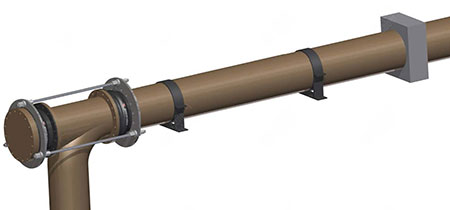
Rubber expansion joints are designed to absorb anticipated piping movements or displacements, reduce noise and vibration and have a life cycle in the tens of millions. They also compensate for misalignments, provide access to piping and equipment, and relieve pipe and anchor stresses.

well-anchored and well-guided pipe section
(Images courtesy of FSA)
The most important design function is their ability to absorb fluctuating thermal or external movements in an otherwise ridged piping systems, and thereby replacing or exchanging the often catastrophic effects of these stresses with the inherently low stiffness or spring rate of the rubber expansion joint.
To select from the different styles of rubber expansion joints, it is helpful to divide the proposed piping system into individual sections (i.e., straight runs, L- or Z-shaped bends) by choosing tentative anchor locations. If an individual
section is well-anchored and well-guided, an unrestrained rubber expansion joint style represents an optimal and cost-effective arrangement.
If an individual section has limited support structure or load limitations on the adjacent equipment, then selecting from restrained rubber expansion joint styles often represents the most effective solution. The restrained styles restrain, or better manage, the pressure thrust forces within the piping system.
Once each section is optimized, by taking advantage of a given style, it then can be incorporated back into the complete piping system. This sometimes-iterative approach requires some additional design considerations including the capabilities and limitations of different rubber expansion joint styles.
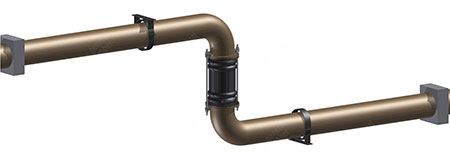
Unrestrained rubber expansion joints are designed to absorb all directional movements in well-anchored and well-guided piping systems. Their spool-type body is often constructed with full rubber flanges, a high-grade leak-proof tube, multiple layers of high-strength tire cord, high tensile steel reinforcement, a seamless cover and galvanized retaining rings.
Image 1, as a standalone expansion joint, represents the most cost-effective arrangement when used in rigid piping systems with main anchors (MA) and numerous guides at specific spacing. Control units can be externally or internally attached and used as limit rods for secondary restraint.
Universal Rubber Expansion Joints
This type features two resilient arch sections separated by a straight section to facilitate greater lateral movement capability. This single unit arrangement is an effective solution for absorbing axial thermal movements from adjacent pipe runs.
The spool-type body is often constructed with full rubber flanges, a high-grade leak-proof tube, multiple layers of high-strength tire cord, high tensile steel reinforcement, a seamless cover and galvanized retaining rings.
The control units are externally or internally attached and used as limit rods for secondary restraint in a properly anchored piping system or as tie rods when the support structure or adjacent equipment have load limitations.
Hinge Rubber Expansion Joints
Designed to facilitate and isolate angular rotation in one plane, this arrangement consists of a pair of hinge plates connected with pins and attached to the expansion joint’s external or internal hardware. The hinge assembly must be designed for the internal pressure thrust forces of the system.
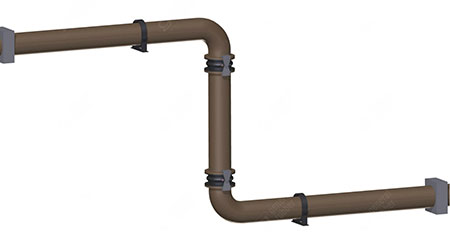
These can be used in sets of two or three to absorb large lateral movements in a single plane. This arrangement is an effective solution for absorbing large axial thermal movements from an adjacent pipe run. The spool-type body is often constructed with full rubber flanges, a high-grade leak-proof tube, multiple layers of high-strength tire cord, high tensile steel reinforcement and a seamless cover.
They are commonly used when the support structure or adjacent equipment has load limitations. The economic benefits of this arrangement include a smaller system footprint with far fewer anchors and guides.
Gimbal Rubber Expansion Joints
This design facilitates and isolates angular rotation in two planes. The arrangement consists of two pairs of hinge plates connected with pins to a common gimbal ring and attached to the expansion joint’s external or internal hardware. The gimbal assembly must be designed for the internal pressure thrust forces of the system. They can be used in sets of two or sets of two with a single hinge design to absorb large lateral movements in multiple planes. This optimally designed arrangement is an effective solution for absorbing large axial thermal movements from adjacent pipe runs.
The spool-type body is often constructed with full rubber flanges, a high-grade leak-proof tube, multiple layers of high-strength tire cord, high tensile steel reinforcement and a seamless cover. They are commonly used when the support structure or adjacent equipment have load limitations. The economic benefits of this arrangement include a smaller system footprint with fewer anchors and guides.
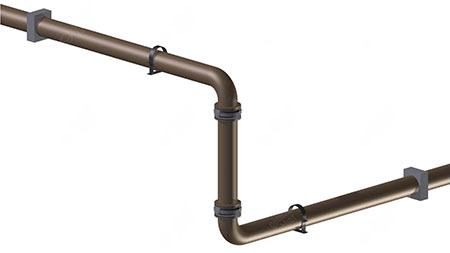
In-line Pressure Balanced Rubber Expansion Joints
This type provides the only effective solution for directly absorbing large axial thermal movements while continuously self-restraining the pressure thrust forces. This arrangement consists of tie devices interconnecting the main joint sections to the opposing balancing joint section and is commonly used when the support structure or adjacent equipment have load limitations. The body is often a one-piece rubber construction with full rubber flanges, a high-grade leak-proof tube, multiple layers of high-strength tire cord, high tensile steel reinforcement, a seamless cover and galvanized retaining rings.
The economic benefits of using pressure balanced designs include a smaller system footprint as well as far fewer guides, anchors and supports.
Elbow Pressure Balanced Rubber Expansion Joints
Designed to absorb all directional movement while continuously self-restraining the pressure thrust forces, this arrangement consists of tie devices interconnecting the main joint section to the opposing balancing joint section and is commonly used when the support structure or adjacent equipment have load limitations.
The pair of spool-type bodies are often constructed with full rubber flanges, high-grade leak-proof tubes, multiple layers of high-strength tire cord, high tensile steel reinforcements, seamless covers and galvanized retaining rings. The economic benefits include a smaller system footprint as well as far fewer guides, anchors and supports.
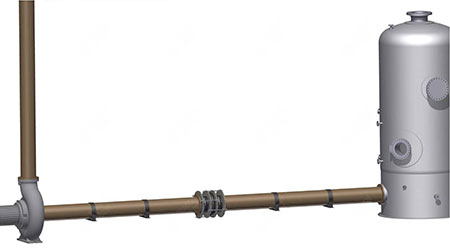
An unrestrained rubber expansion joint style often represents an optimal and cost-effective solution when installed in a well-anchored and well-guided pipe section. The restrained rubber expansion joint styles including the universal, hinge, gimbal, in-line pressure balanced, and elbow pressure balanced all additionally manage the pressure thrust forces within the piping system.
The selection and application of these styles are particularly useful in systems where the support structure or adjacent equipment have load limitations. The economic benefits of restrained styles include a smaller system footprint as well as far fewer guides, anchors and support structure. In many cases, multiple solutions are possible allowing for an owner’s preference.
We invite your suggestions for article topics as well as questions on sealing issues so we can better respond to the needs of the industry. Please direct your suggestions and questions to sealingsensequestions@fluidsealing.com.

